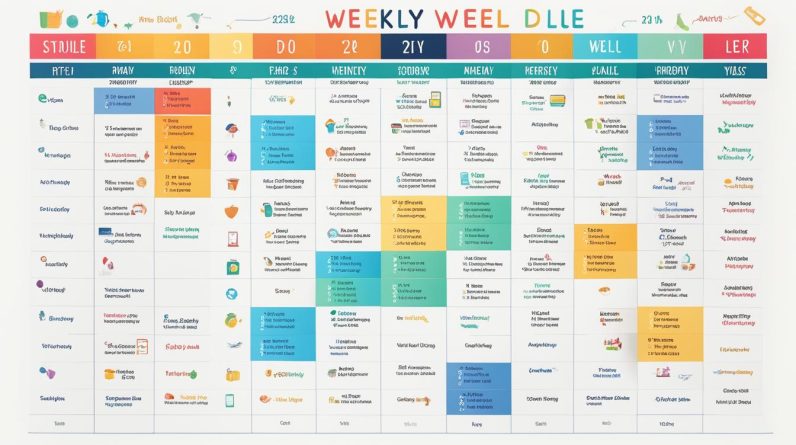Are you considering part-time homeschooling but worried about how to balance it with your other responsibilities? In this article, we will explore the challenges and benefits of part-time homeschooling and provide valuable tips and resources to help you find a harmonious balance between work, homeschooling, and family life. We will draw insights from Oak Meadow, an organization that believes anyone can homeschool, even while working. By getting organized, utilizing weekends and vacations, getting help, and activating your network, you can successfully navigate the world of part-time homeschooling.
Key Takeaways:
- Part-time homeschooling offers a flexible alternative to full-time homeschooling.
- Getting organized is crucial for balancing work and homeschooling responsibilities.
- Utilizing weekends, summertime, and vacations can maximize learning opportunities.
- Getting help from family, friends, or tutors can lighten the homeschooling load.
- Building a supportive network can provide valuable resources and emotional support.
Can You Work and Homeschool at the Same Time?
Many families wonder if it is possible to balance work and homeschooling simultaneously. The answer is yes! With determination, flexibility, and some careful planning, you can successfully navigate the challenges of working and homeschooling.
When it comes to balancing work and homeschooling, finding a healthy equilibrium is key. It may require some trial and error to discover what works best for you and your family, but with the right strategies in place, it is definitely achievable.
Remember, homeschooling allows for flexibility and customization, making it possible to tailor your schedule to accommodate both your work and your child’s educational needs. By implementing effective time management techniques and utilizing available resources, you can make significant progress in your child’s education while fulfilling your work obligations.
It’s important to approach this journey with determination and patience. Set realistic expectations and be open to adjustments along the way. Balancing work and homeschooling will require careful planning, but the rewards are worth it. Your child will experience a personalized education, and you’ll have the opportunity to actively participate in their learning journey.
At Oak Meadow, we believe that anyone can homeschool, even while working full-time or part-time. Our curriculum and resources provide flexibility and support to help you create a successful homeschooling experience alongside your work commitments. With Oak Meadow, you can find the balance and rhythm that works for your family.
As you embark on this adventure of balancing work and homeschooling, remember to maintain a sense of humor. There may be challenging days, but with perseverance and a positive attitude, you can overcome any obstacles that come your way.
Our next section will provide valuable tips and strategies for getting organized and finding a rhythm that suits your work and homeschooling needs. Let’s dive in!
What Real Parents Say:
“Balancing work and homeschooling was a little daunting at first, but once we found a routine that worked for our family, it became much easier. My children have thrived academically and emotionally, and I have the freedom to actively participate in their education while pursuing my career.”
– Sarah Johnson, Working Mom and Homeschooler
“Working part-time and homeschooling has allowed me to have a deeper connection with my children and witness their academic progress firsthand. It requires flexibility and careful planning, but the rewards are immeasurable. I am grateful for the opportunity to be fully present in my children’s education.”
– Mark Collins, Part-Time Working Dad and Homeschooler
| Pros of balancing work and homeschooling | Cons of balancing work and homeschooling |
|---|---|
|
|
Get Organized for Success
One key to successfully balancing work and homeschooling is organizing your schedule and creating routines. By implementing effective organization strategies, you can ensure a smoother homeschooling experience for both you and your children.
Create a Homeschool Schedule
To stay organized and maintain a productive homeschooling routine, it is essential to create a schedule that works for your family. Start by evaluating your work hours and other commitments, and then allocate dedicated blocks of time for homeschooling. Consider the unique needs and preferences of your children when designing the schedule.
“The secret of your success is determined by your daily agenda.” – John C. Maxwell
Having a structured schedule provides a sense of routine and helps children understand expectations. It also allows you to plan ahead and allocate specific time slots for different subjects or activities. A well-organized homeschool schedule can help you maintain a harmonious balance between work and teaching.
Consolidate Extracurricular Activities
When organizing your homeschool schedule, consider consolidating extracurricular activities on specific days of the week. This approach can help reduce disruptions and allow for more focused learning time.
For example, you can designate Mondays and Wednesdays for art and music lessons, Tuesdays and Thursdays for sports or physical education activities, and Fridays for science experiments or field trips. Consolidating extracurricular activities not only streamlines your schedule but also provides structure and variety to your homeschooling routine.
Involve Children in Household Tasks
As you juggle work and homeschooling, involving your children in household tasks can help teach them life skills while also reducing your workload. Assign age-appropriate chores to your children, such as setting the table, doing laundry, or cooking simple meals.
By sharing responsibilities, you can create a sense of teamwork and teach valuable lessons in responsibility and time management. Additionally, involving your children in household tasks provides opportunities for practical learning and reinforces the importance of contributing to the family’s well-being.
Establish a Schedule for Housework
In addition to homeschooling, household chores and maintenance tasks are an integral part of daily life. To maintain a tidy and organized home, establish a schedule for housework that aligns with your homeschooling routine.
Designate specific days or times for tasks such as cleaning, grocery shopping, meal prepping, and other household responsibilities. By incorporating housework into your schedule, you can ensure a well-maintained home environment while also keeping your homeschooling routine on track.
Regularly Check-In and Review the Daily Plan
To maintain organization and ensure that everyone stays on track, regularly check in with your children and review the daily homeschooling plan. This practice helps them understand the goals for the day, prepares them mentally, and provides an opportunity to address any questions or concerns they may have.
Take a few minutes in the morning or the evening prior to discuss the plan for the day, review assignments, and set expectations. This consistent communication helps create a sense of structure and keeps everyone focused and motivated.
Utilize Resources for Homeschooling Success
When it comes to homeschooling, there are numerous resources available to support you in creating a well-structured and successful learning environment. One such resource is Oak Meadow’s Study Skills Tool Kit.
“Education is not the learning of facts, but the training of the mind to think.” – Albert Einstein
The Study Skills Tool Kit provides valuable tips and guidance on organizing homeschool schedules, cultivating focus and motivation, and developing effective study habits. It can serve as a valuable companion resource in your homeschooling journey, helping you and your children thrive academically.
Utilizing Weekends, Summertime, and Vacations
Part-time homeschooling offers the flexibility to make the most of weekends, summertime, and vacations for your child’s education. By reimagining the traditional school year and weekly schedule, you can tailor a homeschool curriculum that works best for your family. Some families even opt for year-round homeschooling, taking breaks as needed. Setting aside dedicated academic time on weekends can help maintain momentum and ensure continued progress.
“Weekends are a valuable resource for homeschooling families. Use them wisely to focus on specific subjects or engage in hands-on learning experiences that may require more time and attention. It’s an opportunity to delve deeper into topics that excite your child and explore their interests.”
During the summer months, when traditional schools are on break, you can take advantage of the extra time and flexibility homeschooling provides. Incorporate outdoor activities, field trips, and educational projects to make learning an enjoyable and enriching experience. Use the warm weather and longer days to explore nature, visit museums, and engage in hands-on science experiments.
Additionally, vacations don’t have to interrupt your child’s education. Use travel experiences as an opportunity for real-world learning. Research the destination, study its history and culture, and involve your child in the planning process. While on vacation, encourage them to document their experiences through journaling, photography, or creating a travel scrapbook to integrate learning into their travels.
Remember, homeschooling offers a flexible schedule that allows you to adapt to your family’s needs. Whether it’s homeschooling on weekends, during the summer, or while on vacation, embrace the freedom and flexibility that homeschooling provides to create a customized learning experience for your child.

| Benefits of Utilizing Weekends, Summertime, and Vacations | Tips for Maximizing Learning Opportunities |
|---|---|
|
|
Getting Help and Taking Turns
When it comes to balancing work and homeschooling, it’s essential to have support and share responsibilities. Trying to do it all on your own can quickly lead to burnout and exhaustion. That’s why it’s important to consider getting help from various sources and embracing the concept of taking turns.
Sharing Homeschooling Responsibilities
Partnering with family members, babysitters, tutors, or other homeschooling families can be a game-changer. By sharing the load, you not only get much-needed assistance but also bring fresh perspectives and ideas into your homeschooling routine.
“Homeschooling is not a one-person job. It takes a village, and that’s perfectly okay.” – Jessica, a homeschooling parent.
Delegating responsibilities allows you to have more time for work-related tasks or personal activities while ensuring your child receives the attention and education they need. Whether it’s having a family member help with a specific subject or partnering with a babysitter to supervise learning activities, sharing homeschooling responsibilities can help maintain balance and prevent overwhelm.
Co-Teaching in Homeschooling
Co-teaching is another effective strategy for balancing work and homeschooling. This approach involves collaborating with another homeschooling parent to share the teaching responsibilities. By partnering with someone who has complementary skills, you can create a dynamic learning environment for your children.
Co-teaching allows you to divide subjects and topics based on each parent’s strengths and expertise. For example, if you excel in math but struggle with English, you can focus on teaching math while your co-teacher handles English lessons. This not only lightens the workload but also introduces your child to different teaching styles and perspectives.
Partnering with a Babysitter for Homeschooling
If you have work commitments that require your full attention, partnering with a reliable babysitter can be a valuable solution. A qualified babysitter can provide supervision and guidance to your child during designated homeschooling hours, allowing you to focus on your work responsibilities.
When selecting a babysitter, look for someone who understands and aligns with your homeschooling goals. Discuss your expectations, the curriculum you’re following, and any specific routines or activities you want the babysitter to incorporate. Open communication and regular check-ins with the babysitter can help ensure a smooth transition and consistent learning experience for your child.
Benefits of Getting Help and Taking Turns
The benefits of getting help and sharing responsibilities in homeschooling extend beyond the practical aspects. It fosters a sense of community, strengthens relationships, and provides opportunities for learning and growth for everyone involved.
By involving others, you not only lighten your workload but also create a support network where you can exchange ideas, share resources, and find emotional support. It’s a collaborative effort that allows you to tap into the wisdom and experiences of others, enhancing the overall homeschooling experience.
Remember, homeschooling is not meant to be a solitary journey. Embrace the idea of getting help and taking turns, and you’ll find that it brings more joy, balance, and success to your homeschooling and work-life.
| Benefits of Getting Help and Taking Turns |
|---|
| Lightens the workload for homeschooling teachers |
| Introduces fresh perspectives and ideas into homeschooling |
| Provides opportunities for collaboration and co-teaching |
| Allows for time to focus on work and personal activities |
| Fosters a sense of community and support |
| Creates opportunities for learning and growth for everyone involved |
Activating Your Network
In most parts of the U.S., there are well-organized homeschool groups and co-ops that offer support, workshops, classes, and field trips. These communities can provide valuable opportunities for networking, sharing resources, and receiving support from parents who understand the challenges of balancing work and homeschooling.
Joining homeschooling support groups and co-ops allows you to connect with like-minded individuals who can offer guidance and advice based on their own experiences. These groups often organize events and activities where children can engage in social interactions while parents can network and build relationships.
Beyond formal homeschool organizations, consider leveraging your personal network for additional support. Reach out to babysitters, tutors, neighbors, friends, and family members who can provide assistance and engage in your child’s learning journey.
Finding Support and Resources
Seeking support from homeschooling communities can ease the challenges of balancing work and homeschooling. Here are some valuable resources where you can find networking opportunities and support:
- Homeschool Support Groups: Find local homeschool support groups in your area through online directories, community centers, or social media platforms. These groups often organize regular meetings and events, offering a chance to connect with other homeschooling families.
- Homeschool Co-ops: A homeschool co-op is a group of families who come together to share the responsibility of teaching and enriching their children’s education. Co-ops typically offer classes taught by parents or hired instructors, providing opportunities for collaboration and shared learning.
- Homeschooling Community: Online homeschooling communities, forums, and social media groups can be valuable sources of support and networking. These platforms allow you to connect with experienced homeschoolers, ask questions, and exchange ideas and resources.
- Homeschooling Networking: Attend homeschooling conferences, workshops, and seminars to network with professionals, educators, and other homeschooling families. These events offer opportunities to gain insight, seek guidance, and build relationships within the homeschooling community.
Building a robust network of homeschooling support can provide you with the encouragement, resources, and connections needed to successfully balance work and homeschooling.
“Homeschooling support groups and co-ops offer a sense of community and belonging, giving you the chance to connect with other homeschooling families who understand the unique challenges you face.”

| Homeschool Support Resources | Benefits |
|---|---|
| Homeschool Support Groups |
|
| Homeschool Co-ops |
|
| Homeschooling Community |
|
| Homeschooling Networking |
|
Simplify and Streamline
To make homeschooling more manageable while balancing work, it is important to simplify and streamline your approach. By adopting efficient strategies and customizing your curriculum, you can create a smoother homeschooling experience for yourself and your children.
Customize Your Curriculum
One way to simplify homeschooling is by using a curriculum that can be easily customized for different grade levels. This allows you to teach multiple children at once, saving time and effort. Look for flexible curriculum options that provide a range of materials and activities to suit your family’s needs.
Implement the “Bus Stop” Method
Another effective way to streamline homeschooling is by implementing the “bus stop” method. In this approach, children work independently on their assignments and come to you for one-on-one time when they need assistance. This maximizes efficiency by allowing you to focus your attention on individual needs while promoting independence and self-motivation in your children.
“The ‘bus stop’ method has been a game-changer for our homeschool. It allows me to work while my children work independently, and we come together for meaningful learning moments throughout the day.” – Sarah, homeschooling parent
Focus on the Whole Package
Remember, homeschooling is about more than just checking off tasks. It’s about creating a holistic learning experience for your children. While it’s essential to cover academic subjects, don’t forget to prioritize other aspects of education, such as life skills, socialization, and personal development. By focusing on the whole package, you can create a well-rounded education that prepares your children for the future.
Comparison of Homeschool Curriculum Options
| Curriculum Option | Features | Pros | Cons |
|---|---|---|---|
| Pre-Packaged Curriculum | Ready-to-use materials | – Saves time on planning – Provides structure and guidance |
– Limited customization – May not align with specific interests or learning styles |
| Online Curriculum | Interactive lessons and assessments | – Access to a wide range of subjects – Engaging multimedia resources |
– Requires reliable internet connection – Limited offline access |
| Eclectic Curriculum | Customized mix of resources | – Tailored to individual needs and interests – Flexibility to adapt and evolve |
– Requires more planning and organization – May require additional research and resource gathering |

Embrace Flexibility and Balance
One of the joys of homeschooling is the ability to do it your way. Embrace the flexibility that homeschooling offers and tailor it to your child’s needs and interests.
Oak Meadow’s curriculum can be a helpful guide, but feel free to incorporate your own ideas and interests. Don’t stress about achieving learning goals; focus on creating a rich and enjoyable learning experience for your child.
By embracing flexibility, you can design a homeschooling journey that is tailored to your child’s unique learning style, interests, and pace. Here are some tips to help you find the perfect balance in homeschooling:
- Explore Various Teaching Approaches: Research different homeschooling methods such as Montessori, Waldorf, or project-based learning. Experiment with different styles and mix and match approaches that resonate with your child.
- Follow Your Child’s Interests: Incorporate your child’s passions and hobbies into their learning experience. Whether it’s astronomy, art, or gardening, allow them to explore subjects that ignite their curiosity and enthusiasm.
- Be Open to Unconventional Learning: Recognize that learning happens beyond textbooks and traditional classroom settings. Take advantage of real-world experiences, field trips, and hands-on activities to deepen your child’s understanding of the world.
- Design a Flexible Schedule: Create a schedule that accommodates your family’s unique needs. Allow for breaks, playtime, and downtime to prevent burnout and maintain a healthy balance between structured learning and free exploration.
- Embrace Co-learning Opportunities: Seek out homeschooling co-ops, community classes, or online learning communities where your child can connect with other homeschooled students. Collaborative learning experiences can enhance socialization and provide a diverse range of perspectives.

Remember, homeschooling is an opportunity for your child to flourish in a personalized learning environment. Embrace the freedom to adapt and customize your approach to fit your child’s needs and interests.
“Education is not the filling of a pail, but the lighting of a fire.” – William Butler Yeats
Know Your Limits and Prioritize Self-Care
When juggling work and homeschooling, it’s important to know your limits and prioritize self-care. The demands of both can quickly become overwhelming, but by setting boundaries and taking care of yourself, you can maintain a healthy balance and ensure your well-being.
Recognize when you need to scale back and simplify your schedule. It’s okay to say no to commitments that may add unnecessary stress. Remember, your health and well-being should always come first.
Take the time to engage in self-care activities that recharge you. Whether it’s pursuing a hobby, exercising, or simply enjoying a quiet moment alone, prioritizing self-care is crucial for maintaining a healthy balance in your life.
“Self-care is not selfish. You cannot serve from an empty vessel.” – Eleanor Brownn
By taking care of yourself, you’ll have the energy and resilience to handle the challenges of homeschooling and work effectively. Remember, you are both a teacher and a parent, and you deserve to prioritize your own well-being.
Setting Boundaries in Homeschooling
Setting boundaries is crucial when it comes to balancing work and homeschooling. It’s important to establish clear expectations and communicate them to your children. This can include designated work hours, dedicated homeschooling time, and defined spaces for work and learning.
- Designate specific areas in your home for work and homeschooling to create a clear separation between the two.
- Set boundaries around interruptions and distractions during work hours to maintain focus and productivity.
- Establish a daily routine that includes dedicated homeschooling time, breaks, and time for yourself.
Prioritizing Well-Being in Homeschooling
Your well-being should be a top priority in your homeschooling journey. Taking care of yourself goes hand in hand with providing the best education for your child.
- Practice self-reflection and regularly assess your stress levels. Make adjustments to your schedule and commitments as needed to maintain balance.
- Utilize support systems such as homeschooling communities and networks to connect with other parents facing similar challenges.
- Seek out resources and tools that can help streamline your homeschooling journey, freeing up time for self-care and personal well-being.
Remember, homeschooling is a marathon, not a sprint. It’s important to prioritize your well-being and set boundaries to ensure a successful and fulfilling experience for both you and your child.
Plan and Schedule for Success
When it comes to balancing work and homeschooling, effective planning and scheduling are key. By creating a well-structured homeschool schedule, you can optimize your time, maximize productivity, and ensure that both your work and homeschooling responsibilities are given the attention they deserve.
To start, consider using a planner or scheduling tool to help you stay organized. This will allow you to write down and prioritize tasks, ensuring that nothing falls through the cracks. By having a clear visual representation of your schedule, you can easily see what needs to be done and allocate time accordingly.
When creating your homeschool schedule, it’s important to strike a balance between flexibility and structure. While you want to allow for adaptability and spontaneity, having a consistent routine can also provide a sense of stability and help children stay focused.
Begin by mapping out a weekly schedule that designates specific time slots for work and homeschooling. This will help you establish a routine and ensure that both areas are given dedicated attention. Consider the needs of your family and determine when everyone is most productive and receptive to learning. This will vary from household to household, so personalize your schedule accordingly.
Break down larger goals into smaller, manageable tasks that can be tackled on a daily basis. This will prevent overwhelm and make your workload more manageable. By focusing on bite-sized tasks, you’ll be able to maintain momentum and make consistent progress.
Remember that flexibility is crucial when homeschooling. Unexpected events or changes in your work schedule may arise, and it’s important to be able to adapt. Build in buffer time and allow for flexibility within your schedule to accommodate unforeseen circumstances.
Lastly, regularly review and adjust your schedule as needed. As circumstances change, you may need to make modifications in order to maintain balance. Stay attuned to the needs of your family and make changes accordingly, ensuring that your schedule remains optimized for success.
Benefits of Planning and Scheduling:
- Maximize productivity by effectively organizing your time
- Create a sense of structure and routine for your family
- Prevent overwhelm by breaking down tasks into manageable chunks
- Allow for adaptability and flexibility in your schedule
With a well-designed homeschool schedule in place, you’ll be able to effectively manage your time, find a balance between work and homeschooling, and ensure that both areas receive the attention they deserve.
Find Peace in Your Schedule
To achieve balance and serenity in your homeschooling journey, it is crucial to simplify and prioritize. Take a step back and evaluate your commitments and activities, removing those that cause unnecessary stress and overwhelm. Focus on what truly matters to you, your child, and your family, and let go of the rest.
Embrace the power of a well-structured schedule. Set aside dedicated time for work, homeschooling, and personal activities, ensuring that each area receives the attention it deserves. By creating a clear and intentional schedule, you can navigate through the demands of both work and homeschooling while still finding time for yourself.
Simplifying your homeschool routine is key to finding peace in your schedule. Identify the core subjects and activities that align with your educational goals and prioritize them. Streamline your curriculum, opting for resources and materials that are efficient and effective. Remember that homeschooling is not about completing a list of tasks, but about providing a nurturing and enriching learning experience for your child.
By finding balance and tranquility in your schedule, you can create a harmonious rhythm in your homeschooling journey. Remember to be flexible, adaptable, and open to adjustments as needed. Prioritize your well-being and the well-being of your child, knowing that finding peace in your schedule will lead to a more fulfilling and rewarding experience for both of you.
FAQ
Can you work and homeschool at the same time?
Yes, it is possible to work and homeschool at the same time. With organization, flexibility, and support, you can find a balance between work and homeschooling.
How can I get organized for success in part-time homeschooling?
Create systems and routines that work around your schedule and family needs. Involve your children in household tasks and establish a schedule for housework. Regularly check in with your children and utilize resources like Oak Meadow’s Study Skills Tool Kit for ideas on cultivating focus and motivation.
How can I utilize weekends, summertime, and vacations for homeschooling?
By rethinking the traditional school year and weekly schedule, you can craft your own homeschool curriculum and schedule that works for you. Set aside dedicated academic time on weekends to keep momentum and progress moving forward.
How can I get help and share responsibilities in part-time homeschooling?
It is important to have support to avoid burnout. Consider involving family members, babysitters, tutors, or other homeschooling families to share the load. Delegating responsibilities and taking turns can help ensure a happier and healthier balance for everyone involved.
How can I activate my network for support in part-time homeschooling?
Join well-organized homeschool groups and co-ops that offer support, workshops, classes, and field trips. These communities provide valuable opportunities for networking, sharing resources, and receiving support from parents who understand the challenges of balancing work and homeschooling. Babysitters, tutors, neighbors, friends, and family members can also be part of your network for additional support.
How can I simplify and streamline part-time homeschooling?
Consider using a curriculum that can be easily customized for different grade levels, allowing you to teach multiple children at once. Implement a “bus stop” method where children work independently and come to you for one-on-one time to maximize efficiency.
How can I embrace flexibility and balance in part-time homeschooling?
Embrace the flexibility that homeschooling offers and tailor it to your child’s needs and interests. Incorporate your own ideas and interests into the curriculum. Focus on creating a rich and enjoyable learning experience for your child.
How can I know my limits and prioritize self-care in part-time homeschooling?
Recognize when you need to scale back and simplify your schedule. Set boundaries and learn to say no to commitments that may overwhelm you. Take time for self-care activities that recharge you, whether it’s a hobby, exercise, or simply enjoying a quiet moment alone.
How can I plan and schedule for success in part-time homeschooling?
Use a planner or scheduling tool to write down and prioritize tasks, both for work and homeschooling. Create a weekly and daily schedule that allows for dedicated time for both responsibilities. Plan in advance and break down larger goals into smaller, manageable tasks.
How can I find peace in my schedule while balancing work and homeschooling?
Simplify and prioritize by removing commitments and activities that cause stress and overwhelm. Set aside dedicated time for work, homeschooling, and personal activities. By finding peace in your schedule, you can create a harmonious balance between work and homeschooling.






